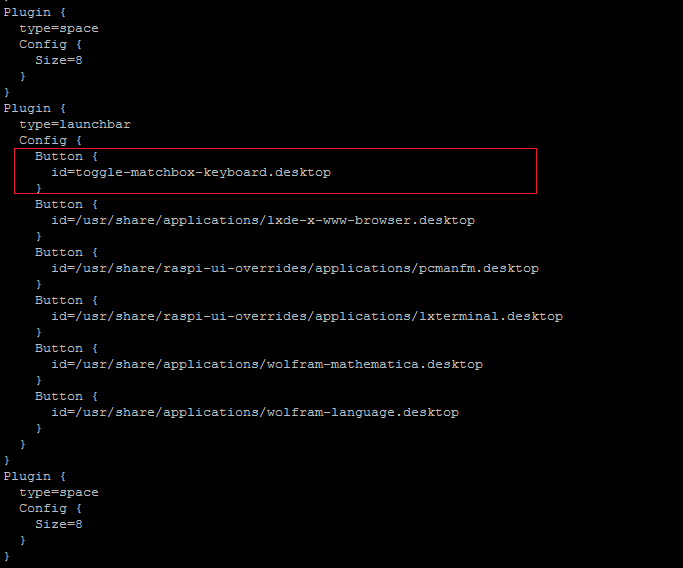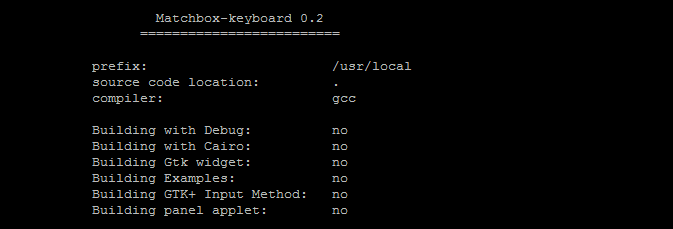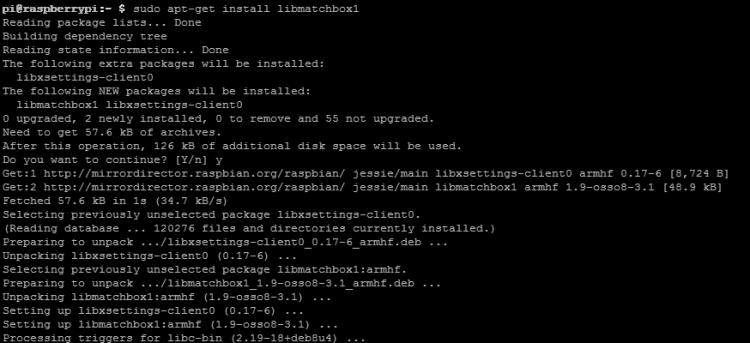More actions
No edit summary |
No edit summary |
||
| Line 29: | Line 29: | ||
Continue: | Continue: | ||
{{code|1= | |||
sudo make | sudo make | ||
sudo make install | sudo make install | ||
</pre> | </pre> | ||
3. Install the shared data library for matchbox-keyboard | 3. Install the shared data library for matchbox-keyboard | ||
{{code|1= | |||
sudo apt-get install libmatchbox1 </pre> | sudo apt-get install libmatchbox1 </pre> | ||
As following: | As following: | ||
| Line 41: | Line 41: | ||
4. Create a virtual keyboard startup script | 4. Create a virtual keyboard startup script | ||
{{code|1= | |||
sudo nano /usr/bin/toggle-matchbox-keyboard.sh | sudo nano /usr/bin/toggle-matchbox-keyboard.sh }} | ||
Paste the following, press Ctrl + X and Y, to save then exit | Paste the following, press Ctrl + X and Y, to save then exit | ||
{{code|1= | |||
#!/bin/bash | #!/bin/bash | ||
#This script toggle the virtual keyboard | #This script toggle the virtual keyboard | ||
| Line 53: | Line 53: | ||
matchbox-keyboard -s 50 extended& | matchbox-keyboard -s 50 extended& | ||
fi | fi | ||
}} | |||
Add executable permission for the script above | Add executable permission for the script above | ||
{{code|1= | |||
sudo chmod +x /usr/bin/toggle-matchbox-keyboard.sh | sudo chmod +x /usr/bin/toggle-matchbox-keyboard.sh }} | ||
5. Add script above to Start menu | 5. Add script above to Start menu | ||
<pre style="border: 1px dashed black;color:black; | <pre style="border: 1px dashed black;color:black;> | ||
sudo nano /usr/share/applications/toggle-matchbox-keyboard.desktop | sudo nano /usr/share/applications/toggle-matchbox-keyboard.desktop | ||
</pre> | </pre> | ||
Paste the following content, press Ctrl + X and Y, to save then exit | Paste the following content, press Ctrl + X and Y, to save then exit | ||
{{code|1= | |||
[Desktop Entry] | [Desktop Entry] | ||
Name=Toggle Matchbox Keyboard | Name=Toggle Matchbox Keyboard | ||
| Line 70: | Line 70: | ||
Icon=matchbox-keyboard.png | Icon=matchbox-keyboard.png | ||
Categories=Panel;Utility;MB | Categories=Panel;Utility;MB | ||
X-MB-INPUT-MECHANSIM=True | X-MB-INPUT-MECHANSIM=True }} | ||
6. Create an icon on the taskbar | 6. Create an icon on the taskbar | ||
(Note that in this step, must be "pi" user privileges, if you use administrator privileges, will not find the file) | (Note that in this step, must be "pi" user privileges, if you use administrator privileges, will not find the file) | ||
| Line 98: | Line 98: | ||
} </pre> | } </pre> | ||
Add the following code to add an icon item | Add the following code to add an icon item | ||
<pre style="border: 1px dashed black;color:black; | <pre style="border: 1px dashed black;color:black;> | ||
Button { | Button { | ||
id=toggle-matchbox-keyboard.desktop | id=toggle-matchbox-keyboard.desktop | ||
} </pre> | |||
After modifying, would show as below: | After modifying, would show as below: | ||
[[File:Soft_Keyboard-03.png|750px]] | [[File:Soft_Keyboard-03.png|750px]] | ||
Revision as of 17:11, 19 May 2018
| 语言选择(Language): | 中文 | EN |
How to install Soft Keyboard:
This installation tutorial uses "2016-05-27-raspbian-jessie" version for testing. If use wheezy or earlier image, then the step5 and step6 have different file paths, please refer to the virtual-keyboard official installation tutorial for specification.
Official reference address (English) http://ozzmaker.com/virtual-keyboard-for-the-raspberry-pi/
1. Install the necessary files
sudo apt-get update sudo apt-get install libfakekey-dev libpng-dev libxft-dev autoconf libtool
2.Install the matchbox-keyboard
git clone https://github.com/mwilliams03/matchbox-keyboard.git cd matchbox-keyboard ./autogen.sh
(Note: "./ autogen.sh" execution takes a few minutes, and would show as follows after running correctly; if it doesn’t show as follows, then need to check to see if there are error Popup Window prompt)
Continue: {{code|1= sudo make sudo make install
3. Install the shared data library for matchbox-keyboard {{code|1=
sudo apt-get install libmatchbox1
As following:
4. Create a virtual keyboard startup script
sudo nano /usr/bin/toggle-matchbox-keyboard.sh
Paste the following, press Ctrl + X and Y, to save then exit
#!/bin/bash #This script toggle the virtual keyboard PID=`pidof matchbox-keyboard` if [ ! -e $PID ]; then killall matchbox-keyboard else matchbox-keyboard -s 50 extended& fi
Add executable permission for the script above
sudo chmod +x /usr/bin/toggle-matchbox-keyboard.sh
5. Add script above to Start menu
sudo nano /usr/share/applications/toggle-matchbox-keyboard.desktop
Paste the following content, press Ctrl + X and Y, to save then exit
[Desktop Entry] Name=Toggle Matchbox Keyboard Comment=Toggle Matchbox Keyboard Exec=toggle-matchbox-keyboard.sh Type=Application Icon=matchbox-keyboard.png Categories=Panel;Utility;MB X-MB-INPUT-MECHANSIM=True
6. Create an icon on the taskbar (Note that in this step, must be "pi" user privileges, if you use administrator privileges, will not find the file)
nano ~/.config/lxpanel/LXDE-pi/panels/panel
7. Find the resembles similar to the following command (default content may be different in different Raspberry Pi versions)
Plugin {
type=launchbar
Config {
Button {
id=/usr/share/applications/lxde-x-www-browser.desktop
}
Button {
id=/usr/share/raspi-ui-overrides/applications/pcmanfm.desktop
}
Button {
id=/usr/share/raspi-ui-overrides/applications/lxterminal.desktop
}
Button {
id=/usr/share/applications/wolfram-mathematica.desktop
}
Button {
id=/usr/share/applications/wolfram-language.desktop
}
}
}
Add the following code to add an icon item
Button {
id=toggle-matchbox-keyboard.desktop
}
After modifying, would show as below:

8. After modifying, run the following command and re-start the system; you will see a virtual keyboard icon in taskbar on the screen normally.
sudo reboot
P.S. Log into via SSH to see how to change the size of the virtual keyboard
DISPLAY=:0.0 matchbox-keyboard -s 50 extended DISPLAY=:0.0 matchbox-keyboard -s 100 extended


